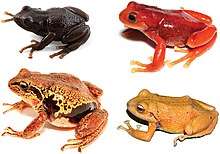Craugastoridae
The Craugastoridae, or fleshbelly frogs, are a family of New World direct-developing frogs. As delineated here, following the Amphibian Species of the World, it is a large family containing 857 species. They are found from the southern United States southwards to Central and South America.[1]
| Craugastoridae | |
|---|---|
 | |
| Pristimantis orcesi, Pristimantis erythros, Pristimantis pycnodermis and Pristimantis loujosti | |
| Scientific classification | |
| Kingdom: | Animalia |
| Phylum: | Chordata |
| Class: | Amphibia |
| Order: | Anura |
| Superfamily: | Brachycephaloidea |
| Family: | Craugastoridae Hedges, Duellman & Heinicke, 2008 |
| Subfamilies and genera | |
|
See the text. | |
Taxonomy
The taxon was created by Stephen Blair Hedges, William Edward Duellman and Matthew P. Heinicke in 2008.[2] The taxonomy of these frogs is not yet settled,[3][4] and other sources may treat the subfamily Strabomantinae as a family, Strabomantidae,[4][5][6] with correspondingly smaller Craugastoridae.[4][7][8] The most recent rearrangement of subfamilies and genera is from 2014.[9]
Life history
With the possible exception of Craugastor laticeps that may be ovoviviparous,[10] craugastorid frogs have direct development: no free-living tadpole stage is known; instead, eggs develop directly into small froglets.[2]
Subfamilies and genera
The following taxonomy follows Padial and colleagues (2014)[9] and is adopted by the Amphibian Species of the World.[1]
Subfamilies
- Ceuthomantinae Heinicke, Duellman, Trueb, Means, MacCulloch, and Hedges, 2009 (567 species) (=Pristimantinae Ohler and Dubois, 2012)
- Ceuthomantis Heinicke, Duellman, Trueb, Means, MacCulloch, and Hedges, 2009 (four species)
- Dischidodactylus Lynch, 1979 (two species)
- Pristimantis Jiménez de la Espada, 1870 (553 species)
- Tachiramantis Heinicke, Barrio-Amorós, and Hedges, 2015 (three species)
- Yunganastes Padial, Castroviejo-Fisher, Köhler, Domic, and De la Riva, 2007 (five species)
- Craugastorinae Hedges, Duellman, and Heinicke, 2008 (139 species)
- Craugastor Cope, 1862 (120 species)
- Haddadus Hedges, Duellman, and Heinicke, 2008 (three species)
- Strabomantis Peters, 1863 (16 species)
- Holoadeninae Hedges, Duellman, and Heinicke, 2008 (151 species)
- "Eleutherodactylus" bilineatus (Bokermann, 1975)
- Barycholos Heyer, 1969 (two species)
- Bryophryne Hedges, Duellman, and Heinicke, 2008 (11 species)
- Euparkerella Griffiths, 1959 (five species)
- Holoaden Miranda-Ribeiro, 1920 (four species)
- Lynchius Hedges, Duellman, and Heinicke, 2008 (7 species)
- Microkayla De la Riva, Chaparro, Castroviejo-Fisher, and Padial, 2017 (25 species)
- Niceforonia Goin and Cochran, 1963 (15 species)
- Noblella Barbour, 1930 (15 species)
- Oreobates Jiménez de la Espada, 1872 (25 species)
- Phrynopus Peters, 1873 (34 species)
- Psychrophrynella Hedges, Duellman, and Heinicke, 2008 (four species)
- Qosqophryne Catenazzi, Mamani, Lehr, and von May, 2020 (3 species)
Taxa formerly in Craugastoridae
The following two taxa were formerly placed in Craugastoridae, but are now incerta sedis within the superfamily Brachycephaloidea, awaiting more data to resolve their position:[9]
- Atopophrynus Lynch and Ruiz-Carranza, 1982 (monotypic)[11]
- Geobatrachus Ruthven, 1915 (monotypic)[12]
References
- Frost, Darrel R. (2015). "Craugastoridae Hedges, Duellman, and Heinicke, 2008". Amphibian Species of the World: an Online Reference. Version 6.0. American Museum of Natural History. Retrieved 14 May 2020.
- Hedges, S. B.; Duellman, W. E. & Heinicke, M. P (2008). "New World direct-developing frogs (Anura: Terrarana): Molecular phylogeny, classification, biogeography, and conservation" (PDF). Zootaxa. 1737: 1–182.
- Frost, Darrel R. (2014). "Higher taxonomy and progress". Amphibian Species of the World: an Online Reference. Version 6.0. American Museum of Natural History. Retrieved 25 April 2014.
- Blackburn, D.C.; Wake, D.B. (2011). "Class Amphibia Gray, 1825. In: Zhang, Z.-Q. (Ed.) Animal biodiversity: An outline of higher-level classification and survey of taxonomic richness" (PDF). Zootaxa. 3148: 39–55.
- "Strabomantidae Hedges, Duellman and Heinicke, 2008". Integrated Taxonomic Information System.
- "Strabomantidae". AmphibiaWeb: Information on amphibian biology and conservation. [web application]. Berkeley, California: AmphibiaWeb. 2014. Retrieved 25 April 2014.
- "Craugastoridae Hedges, Duellman and Heinicke, 2008". Integrated Taxonomic Information System.
- "Craugastoridae". AmphibiaWeb: Information on amphibian biology and conservation. [web application]. Berkeley, California: AmphibiaWeb. 2014. Retrieved 25 April 2014.
- Padial, J. M.; Grant, T.; Frost, D. R. (2014). "Molecular systematics of terraranas (Anura: Brachycephaloidea) with an assessment of the effects of alignment and optimality criteria". Zootaxa. 3825: 1–132. doi:10.11646/zootaxa.3825.1.1. PMID 24989881.
- McCranie, J.R., M.H. Wake, L. Valdés Orellana (2013). "Craugastor laticeps. Possible ovoviviparity". Herpetological Review. 44 (4): 653–654.CS1 maint: uses authors parameter (link)
- Frost, Darrel R. (2015). "Atopophrynus Lynch and Ruiz-Carranza, 1982". Amphibian Species of the World: an Online Reference. Version 6.0. American Museum of Natural History. Retrieved 7 June 2015.
- Frost, Darrel R. (2015). "Geobatrachus Ruthven, 1915". Amphibian Species of the World: an Online Reference. Version 6.0. American Museum of Natural History. Retrieved 7 June 2015.
| Wikispecies has information related to Craugastoridae |